Ah, Kickstarter, you gotta love it. Sure, we all had our fair share of duds over the years but overall it’s always been an enjoyable spectacle for me. From the videos listing upcoming games to the hype-inducing previews that more often than not made me wonder “what were they thinking?” when I held the final product in my hand. From the chance to support a new designer or publisher to lavish products that otherwise would never have happened. Lately though I have more and more lost interest in crowd funding as expansions get announced while the base game is still in fulfillment and it becomes obvious that the majority of projects might look pretty but turn our severely underdeveloped.
One of my most anticipated backings was Pampero, which finally landed on my door step a few weeks ago. Initial impressions of those with access to a prototype copy had seemed genuinely positive, I liked the theme, and it sounded mechanically interesting. Of course that Ian O’Toole artwork and a loose association with Vital Lacerda helped as well. Surely this would restore my faith in crowd funding.
It came as quite the surprise to me that after my first play though, I wasn’t even sure if I wanted to play Pampero ever again. Had I bet on the wrong horse or did I just need more plays to see the brilliance of Pampero’s design? It was hard to tell. So I kept on digging …
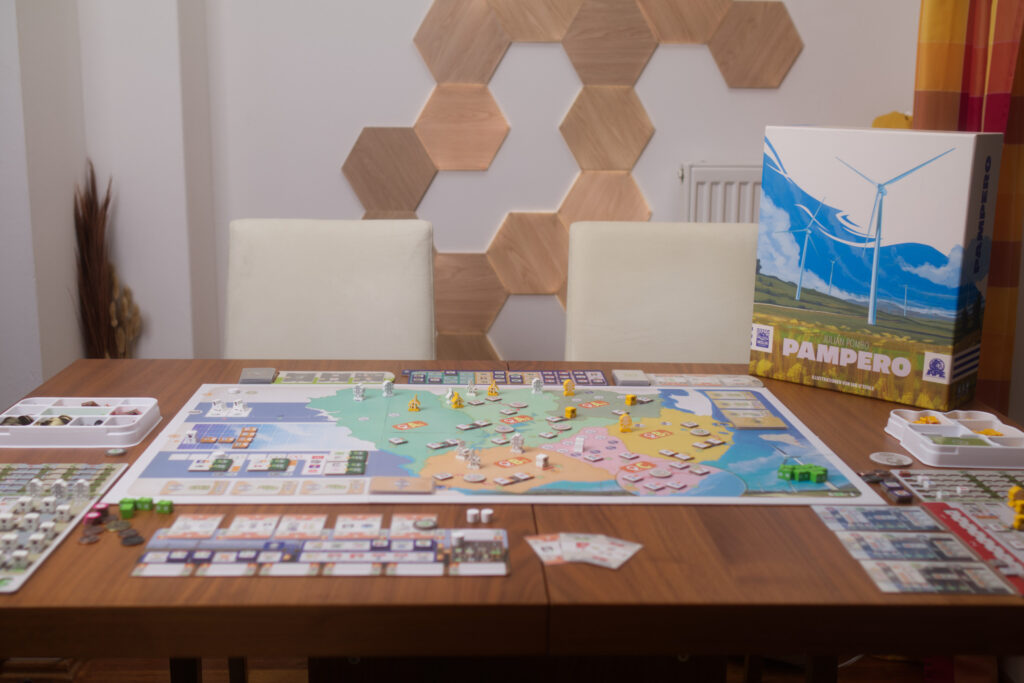
Setup
My first thought opening the package was literally “well THAT’s bigger than I expected”. I know that is strange coming from someone that backed a quite expansive board game and went for the all-in package, but still … imagine a standard Lacerda-Eagle-Gryphon box and then add a third of depth to it. It’s big!
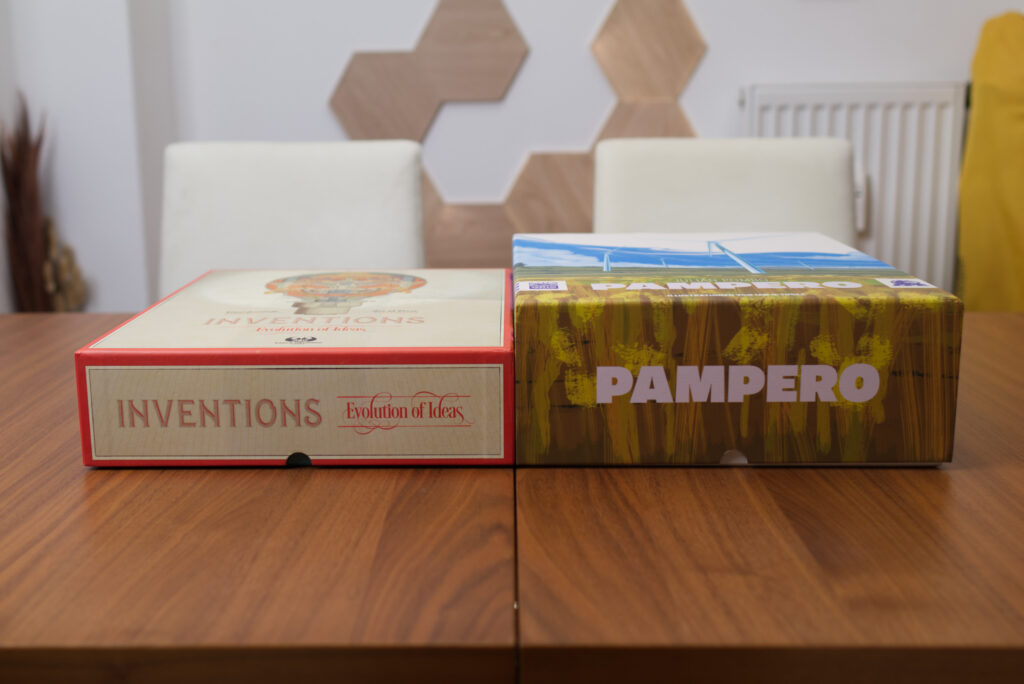
Inside, we find trays for the four player colours, three trays with various cardboard bits and wooden tokens, a dual-side main board, double layer player boards and automa board, cards, smaller side boards, overlays, the list goes on. Granted, a few of the elements belong to the optional two expansions which fit into the main game’s box, but even without them the box wouldn’t be much smaller. It also quickly becomes apparent that this is definitely a table hog!
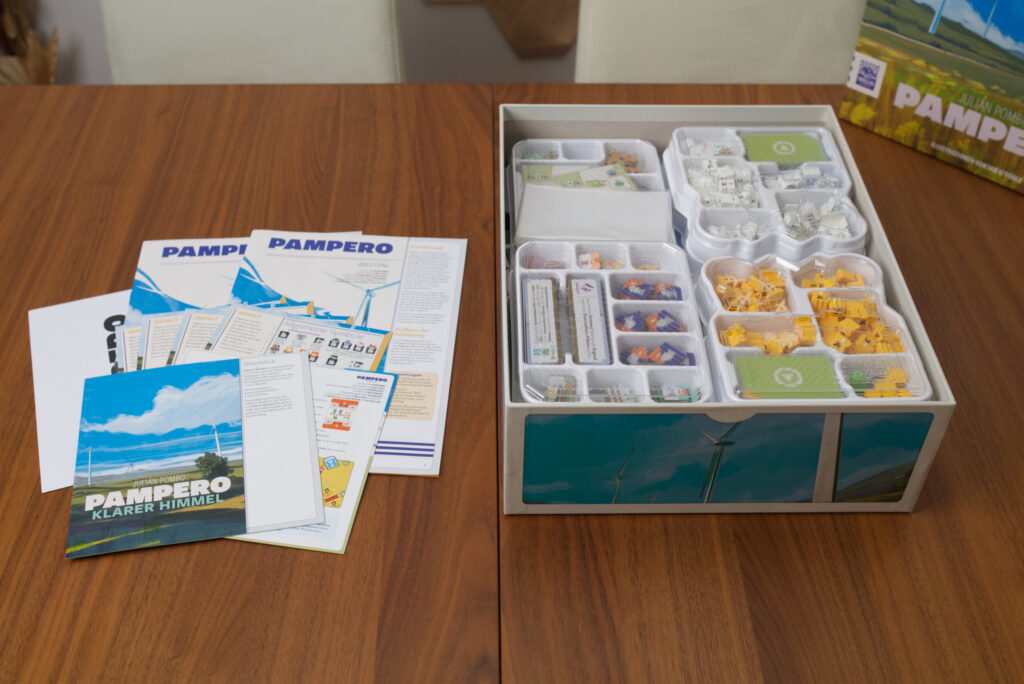
To set up Pampero, we place the somewhat larger than it needs to be feeling main board into the centre and give each player a board representing their power grid, a thin (more like extra thick paper than cardboard) additional board to slot in action cards, and a whole tray of goodies that need to be placed. There are bulldozers, wind farms, electrical towers, transformers, income markers, energy markers, connection tiles, network tiles, … lets just say its a lot and agree on that I’ll be glossing over a lot of details out of necessity as I continue.
The most annoying part of setup is that while each player gets a nice plastic tray, so much time of setup is spent on having to place things somewhere. The biggest offender here are the 27 screen printed wooden transformer tokens which have to be placed in slots on the player’s grid board and have numbers on them in which column they need to be placed. This number is completely irrelevant unless a certain goal card is in play and I’m sure there would have been ways to design this so the transformers could have stayed in their trays.
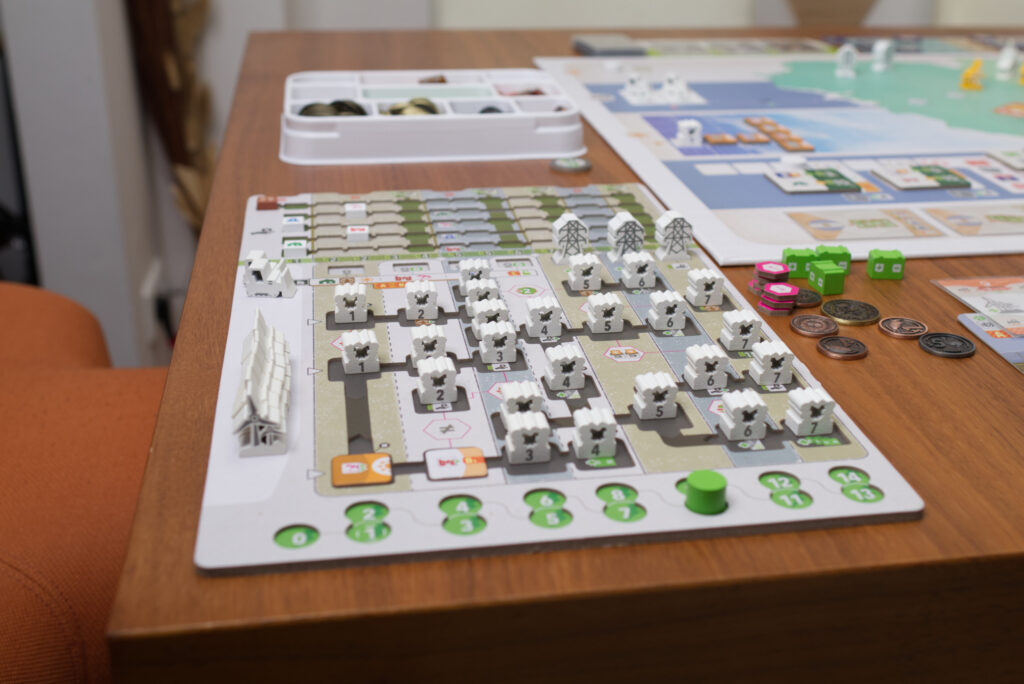
On the main board, things don’t look much better. There are 31 standard contract tiles which each have a unique designation and matching spot on the main board. Then there are two additional contract types (solar and remote) of which only a small random subset are placed on the board each game. There are a couple more elements requiring setup which I again will gloss over and focus instead on the all important timeline track in the lower left of the board. A surprising aspect of Pampero is that it is only played over 5-6 rounds with three scoring phases throughout the course of the game. Each scoring phase is represented by a goal tile which indicates what is getting scored when. E.g. in some games, building a lot of electrical towers will provide additional bonuses while in others having the majority of contracts for a certain class of consumer will award points.
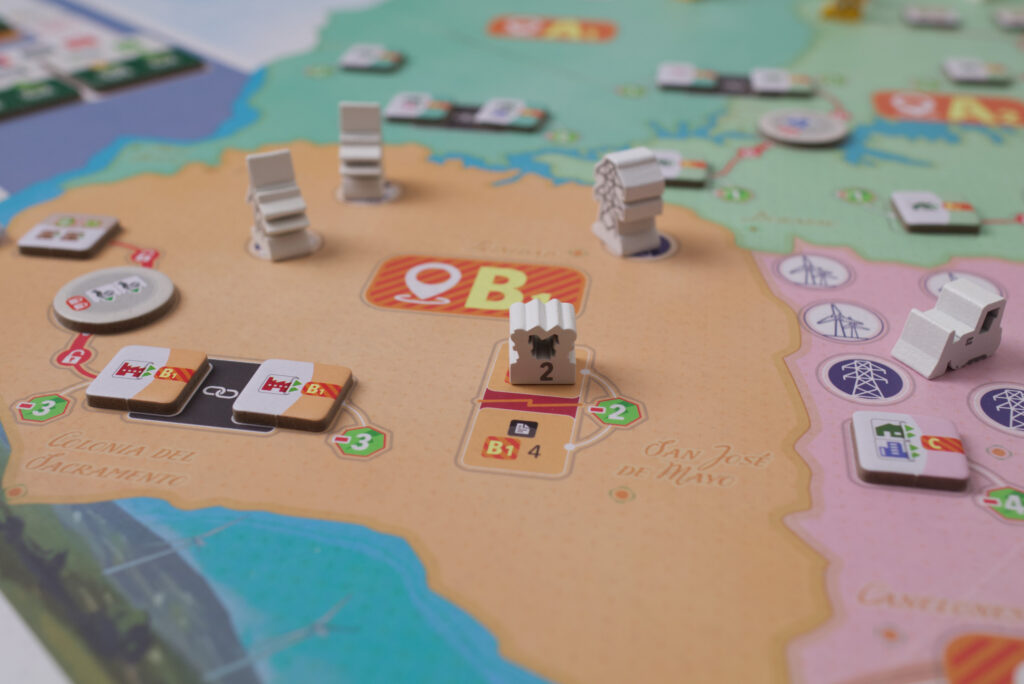
The box also comes with a cardboard overlay that extends the game’s length by one round and shifts the relative position of the scorings. This might seem like a small change but is rather consequential as we will see later.
As if this wouldn’t be enough, there are still some additional side-boards to be readied, two of which are just simple decks with a common display of three cards. The final element is a board with 36 bonus tokens that players can pick up during the game. These need to be split into three groups (A, B, C), shuffled, placed at random, and then a few tiles are removed.
Overall, setup is quite involved. It’s not that bad time-wise but it feels like a lot of busywork for a game that comes with custom trays. Looking at all the elements and symbols on the board, it also becomes apparent very quickly that this teach might take a while.
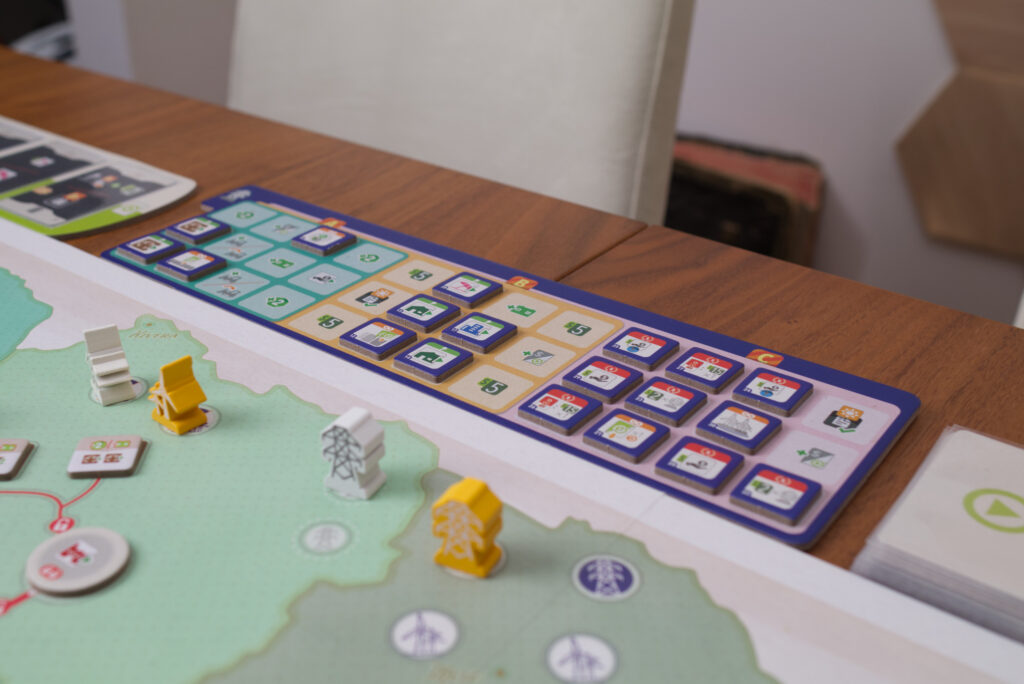
The Turn
Each round in Pampero consists of three turns where every player does one action by playing an action card from their hand. There is no comboing or ways to get additional actions, but still one can achieve a lot in that time. All players start with the same set of 8 cards that they play and lock in into the leftmost empty slot in the top or bottom of their action card board. Each slot is associated with one or two regions of the board the action will then take place in and an associated cost that decreases the farther right a slot is. E.g. doing something in region A starts off costing 8 money but can go down to 0 while doing something in the much more lucrative region C costs a whopping 17 money!
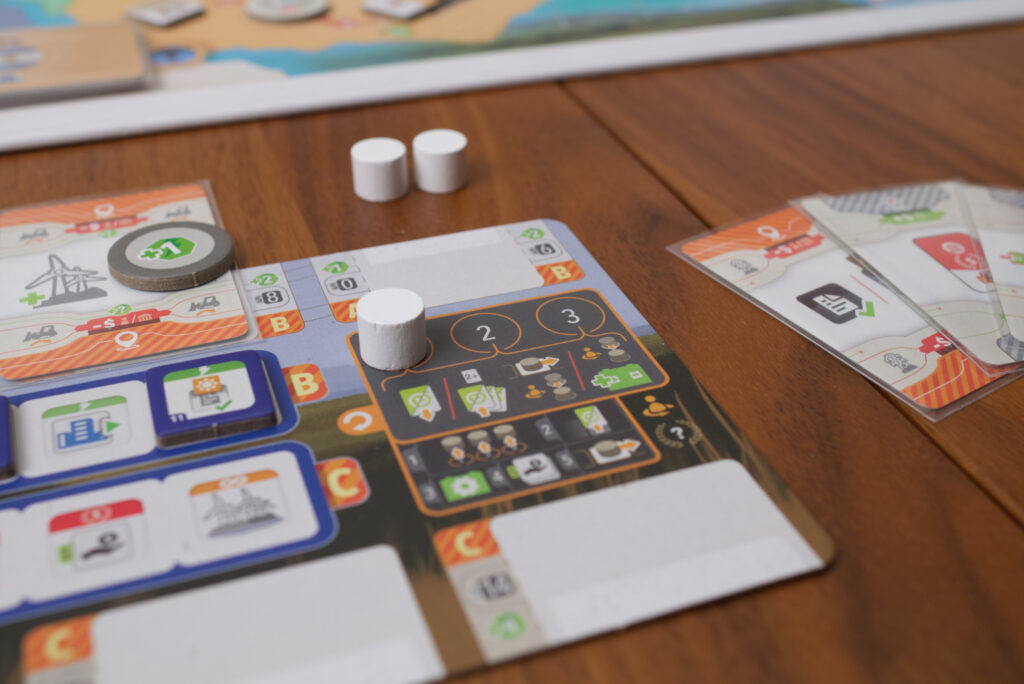
At the end of the round, each player can take back the farthest to the right card from either the top or bottom, but that’s it. While there are ways to get additional action cards during the course of the game, most players will once per game skip a turn to take all their cards back, which gives the game a slight Concordia-vibe. However, that often used comparison doesn’t really work for me as buying more and better action cards is not as relevant here as in Concordia. Buying a new action card in Pampero is more a way to delay having to skip a turn as the functionality on the cards is often less useful than that of the starting cards. They may look enticing at first, but one quickly realises that the opportunity cost of playing them as an action instead of building another wind farm or electrical tower is quite high, simply because there are so few rounds in the game.
So players are incentivised to keep cards in a row to get the price down but on the other hand won’t be able to get those actions back any time soon, except by skipping a whole turn and taking all cards back. At the end of the round, players get income based on the contracts they have fulfilled, produce batteries (an alternate currency besides money) if they have excess energy, get a single action card back, and move their marker forward on the time track. If all players have their marker on or beyond a scoring space, that scoring is triggered.
You might be wondering why I wrote the standard game has 5-6 turns and why each player has their own token on the time track. Skipping a turn to pick all cards back up moves a player an additional step forward which puts them further towards the start in turn order. The full mechanism to decide turn order is a bit more elaborate, but not that interesting, so let’s skip it.
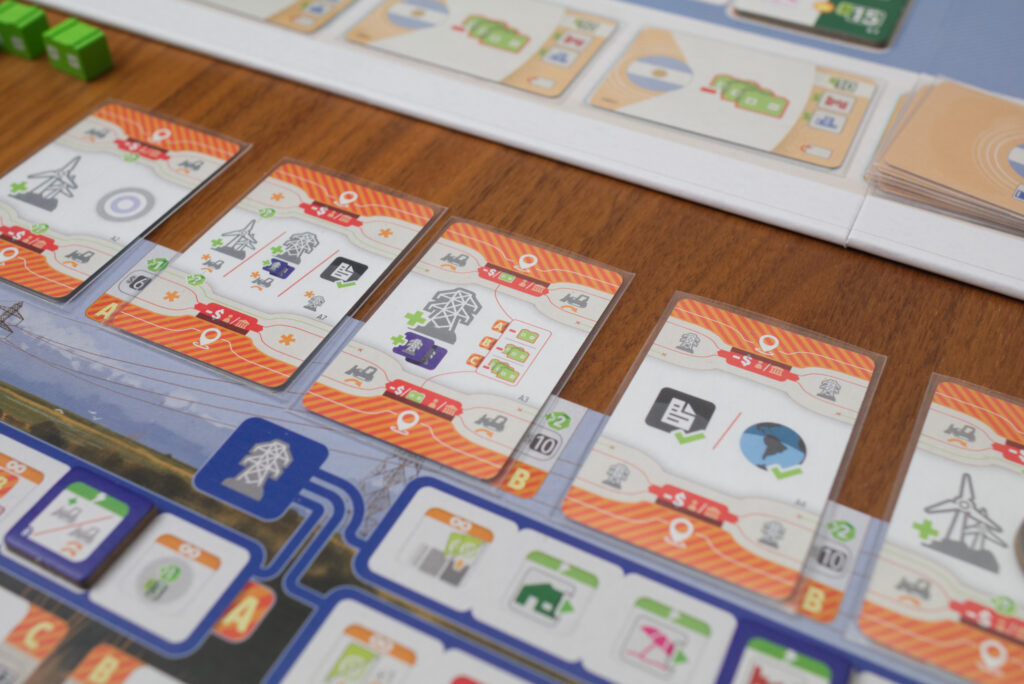
The Core Economy
The largest part of the rulebook deals with explaining the various core actions. The short-short version is that one builds wind farms to get energy, electrical towers to get access to contracts in a new region, and then picks up a contract tile still on the board by paying energy and gaining steps of the respective income markers in return. There are different types of consumers, from households to offices, and in typical Euro-fashion it makes sense to really hone in on one or two types of consumers. That’s the core economic loop: gain energy, gain access, fulfil contracts, increase incoming to be able to pay for more energy and access. Quite unusually, even fulfilling contracts costs money in Pampero, something that’s easy to forget just out of habit from other games.
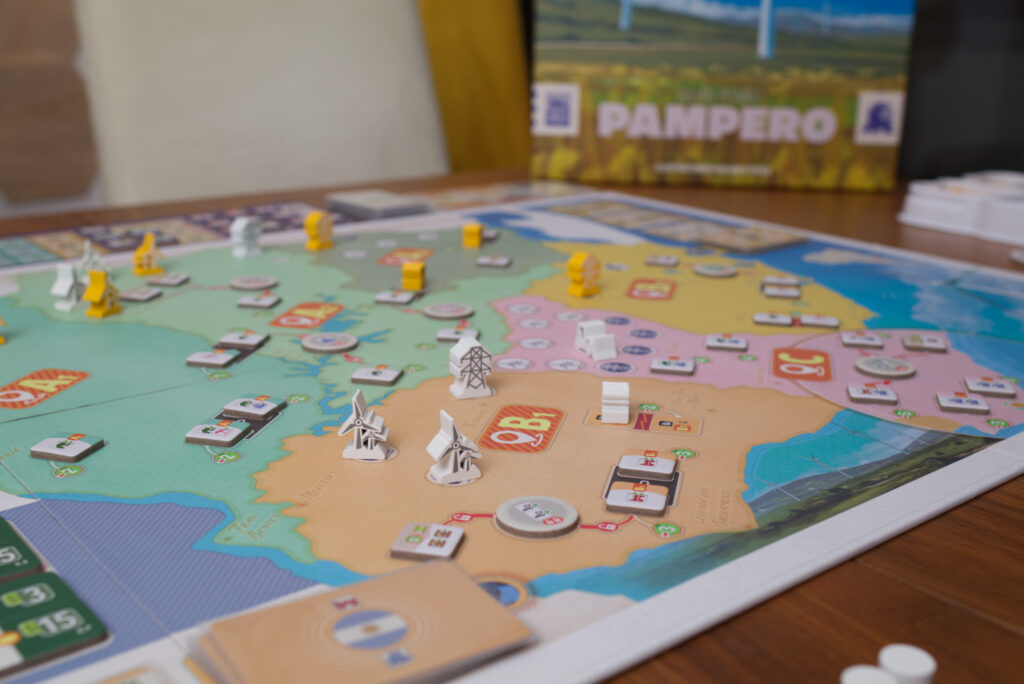
In general, it’s quite challenging to not run out of money quickly and it takes practice and strong focus to get any decent amount of income levels before the game is already over. There is a loan-mechanic in the game, but since taking a lone not only gives players negative VP during end game scoring but also takes an action, the speed factor alone makes it prohibitive to even take one loan, let alone multiple. This is one aspect where batteries come in play.
Batteries are produced at the end of a round if a player both has large amounts of unspent energy and also has built a sufficient number of electrical towers. They can either be used to fulfil so called remote contracts (which are their own type of consumer on the income tracks), to sell them to foreign countries (which strangely is based on the inland contracts one has already fulfilled), or to build electrical towers without paying money. While remote contracts may seem lucrative at first, I now often ignore them because it’s hard to get any decent amount of income out of them. Same for the foreign countries: by the time income markers are high enough to make this lucrative, the game is usually over and other actions are more opportune. Using batteries to build electrical towers, especially in the pricey C-region, is almost a steal though. If a player has the respective action available, they can spent 3 batteries (which they basically got for free by hoarding energy) to save on paying up to 17 money. What also makes batteries attractive is that there are two bonus tiles in the game that can be picked up when building an electrical tower that for the rest of the game give the owner $2 every time they gain a battery! This might not sound much at first, but in an economy where it takes so much effort to increase one’s income, getting both of them is almost game breakingly strong unless the other players start actively hoarding batteries and letting the supply run dry.
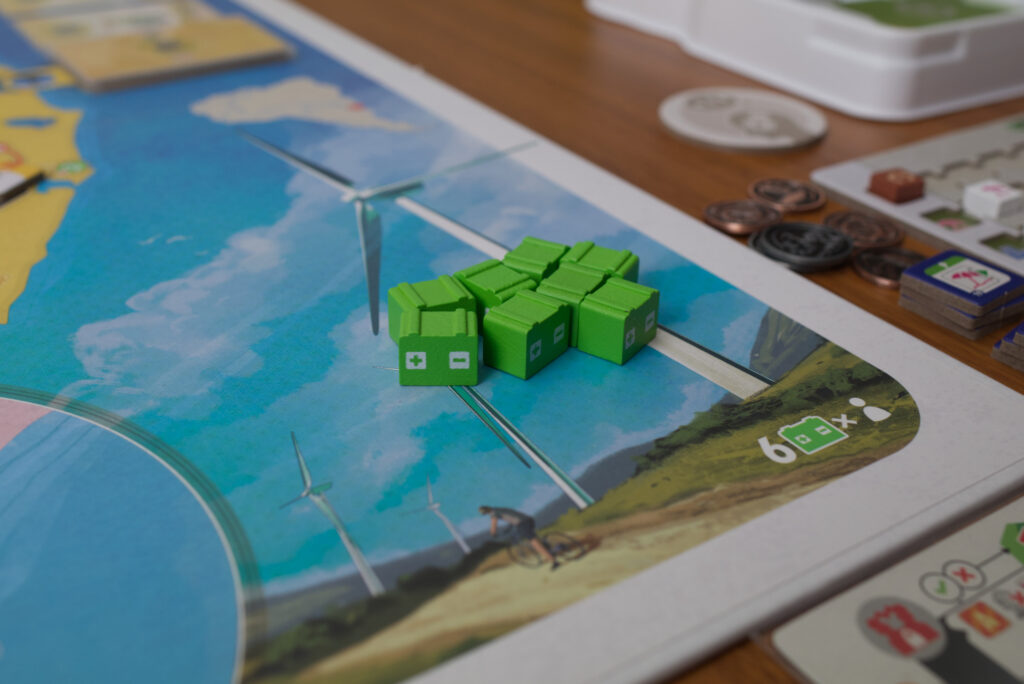
What’s Mine Could Be Yours …
Another layer of complexity that has been put on top of this core economy is that building space is limited and one can use other players’ pieces. For example, to build a new wind farm or electrical tower, a bulldozer is needed. First player to place a bulldozer on to a building space owns that space. If someone wants to build there, they have to pay the construction costs to the owner of the bulldozer or – in case the builder is the owner of the bulldozer – pay it to the bank. If someone wants to fulfil a contract, they need to use an electrical tower in that region but it doesn’t have to be their own. Again, they have to pay the owner or the bank if it is their own.
What sounds like an interesting twist at first unfortunately rather produces more issues than interesting decision points. In most cases, it’s simply too expansive to pay someone else and thus give them a huge boost. There were only two examples I have seen where it really made sense: to pay someone’s electrical tower to snatch away a majority in fulfilling a particular type of contract (e.g. have majorities in industrial contracts) or to rob someone of the last building space in a B region. Since both B regions are geographically separated by the much more expansive C region, being pushed out of one can lead to one’s own bulldozer not being able to go to a lucrative spot for its next building action.
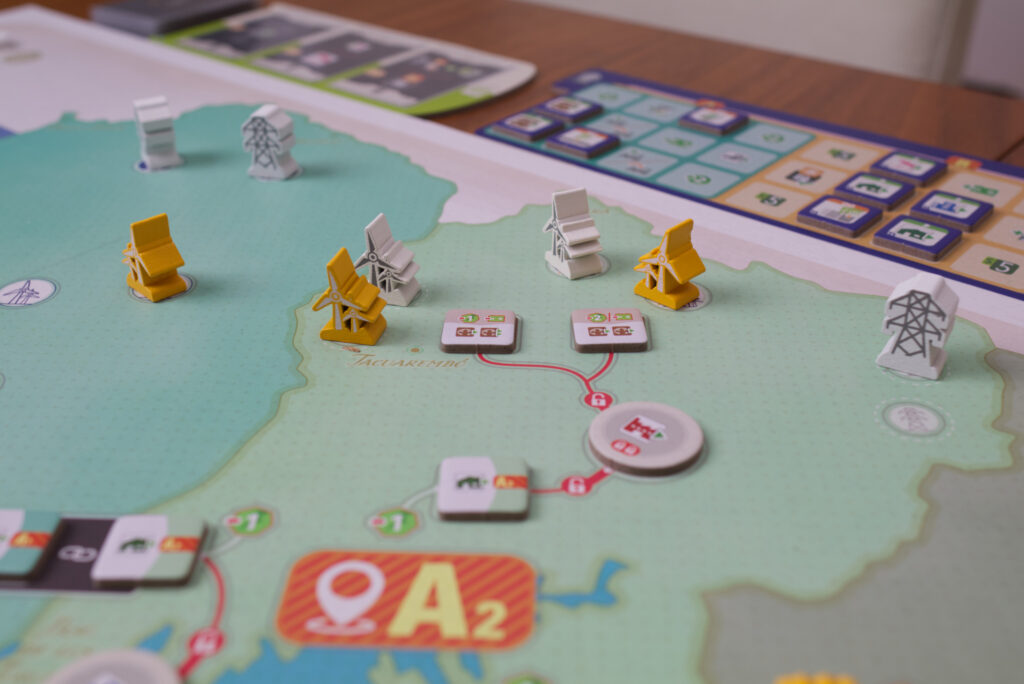
The mixture of paying full price to other players vs paying to the bank can also lead to situations where two players collude and basically build for free while the rest of the players are at a huge disadvantage. There are threads of this happening on BGG and in their recent episode of the Game Brain podcast, the hosts described a similar situation. I haven’t experienced this myself, but that mostly comes from the fact that I have only played solo and two player so far. Knowing my playgroups though, we would do almost anything to avoid giving another player money and I’m not sure if game-theory-wise it actually makes sense for two players to collude in this way because there will always be one that can get the better over the other by stopping to collude. Still, I can totally see how this might completely ruin Pampero for a substantial amount of players.
The Grid Board
The other major complexity is added via the grid board. Whenever a player wants to fulfil a contract, they need an unlocked transformer token and the capability to deliver to that type of consumer. Both are done by building electrical towers. The first few towers have symbols underneath them that show which types of consumers one is allowed to deliver to. Initially, players can only fulfil contracts with housing, remote and solar symbols on them. Tower by tower, more classes of consumers are unlocked when finally with the fourth tower players are allowed to deliver to contracts in the C region.
The towers also unlock transformers. A player is only allowed to use those that are in a column with an empty tower slot. The player then takes the transformer, places it on the board, and places the contract tile in its stead. Additionally, placed contracts have to be connected via lines to already existing ones on the grid board. Sometimes this leads to the player getting bonuses printed on the board, in other situations they have to pay some extra cost to be able to extend their grid in that particular way.
The grid board also features income tracks at the top because those too are limited by the number of towers a player has built.
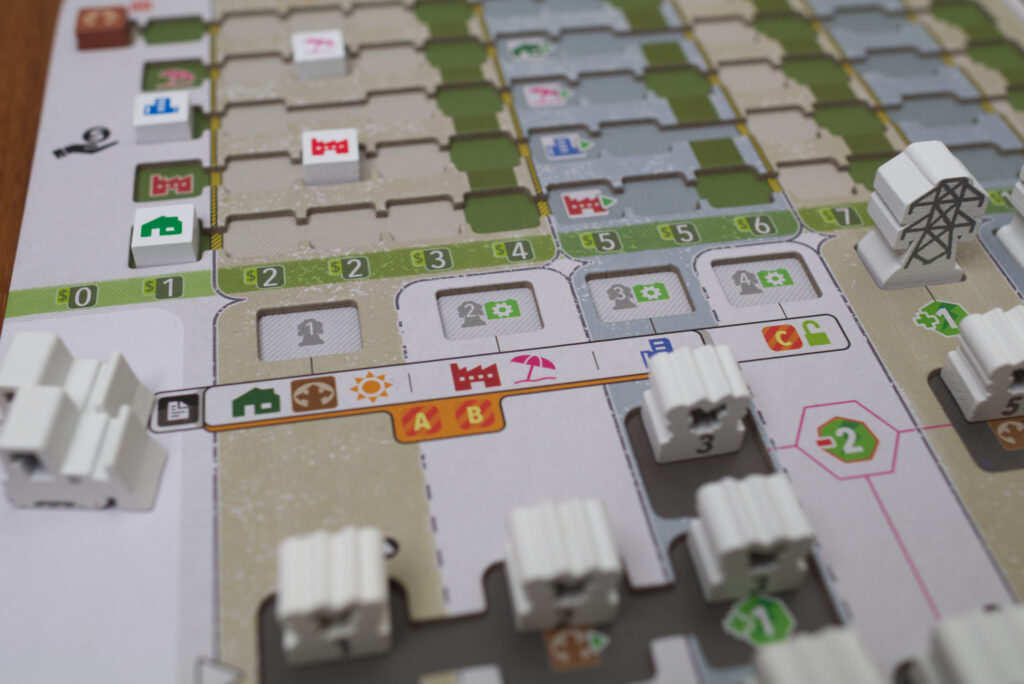
But Wait, There’s More
As if that wouldn’t be enough, there are various side aspects: solar contracts have no cost but can only be fulfilled via special bonuses and one special action card, instead of picking up additional actions players can pick up scoring cards, there is a mechanism to go earlier in turn order, there’s a place to convert bulldozers into bonuses, places where two contracts can be picked up with one action and others where only one of two can be ever fulfilled, connection tiles that provide bonuses when building wind farms, a rather complicated loan mechanism, limited battery market, especially lucrative contract tiles, … in some sense, Pampero with its onslaught of icons reminded me of Voidfall: it’s okay once you get it but a lot to take in when learning the game.
Then there are the multiple suggested variants for rules such as limiting the amount of batteries a player can hold or additional constraints to where contracts titles are placed. And I haven’t even spoken about the two expansions yet …
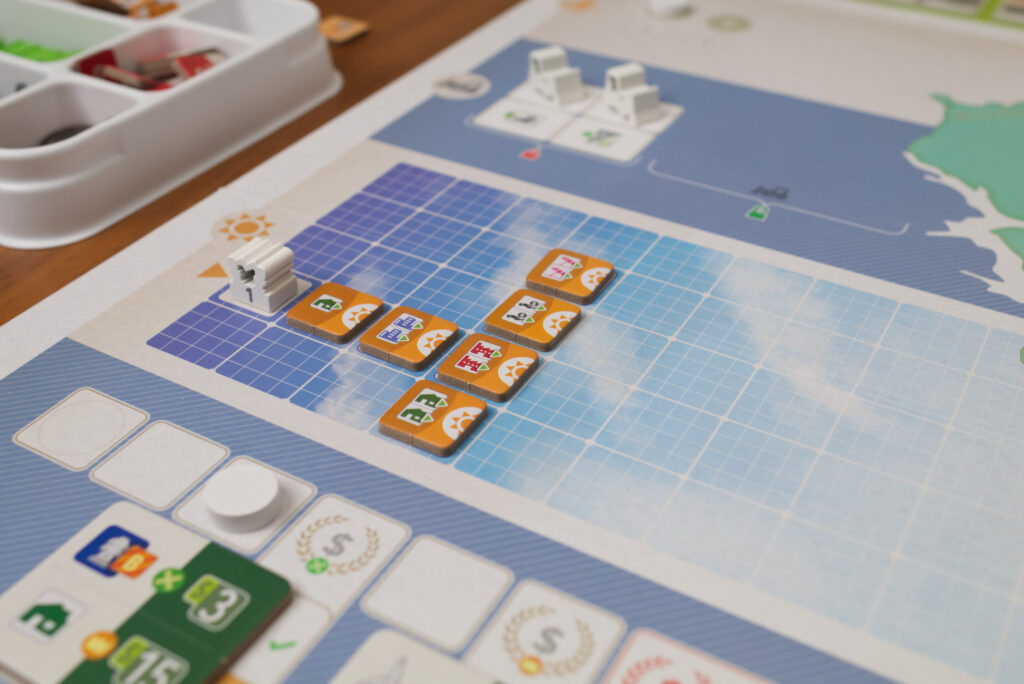
Pampero: Clear Skies is a collection of stretch goals such as unique player powers and comes in the form of various modules that can be added to the game. Pampero: Nature was an optional add-on that adds two more modules. Unfortunately, none of them have official support for solo play (though a BGG user created one) and so I didn’t have a chance to play them. From reading the rules, I’m actually not that interested to try them out. The unique player powers have the most allure to me, but I can’t imagine them being balanced fully. The other thing that felt odd to me is that multiple of the modules add a new action card to the players’ starting hands which seems strange in a game that has limited action choice and forcing players to chose when to take their cards back at its very centre. But as I said: I couldn’t try them, so take all of this with a grain of salt.
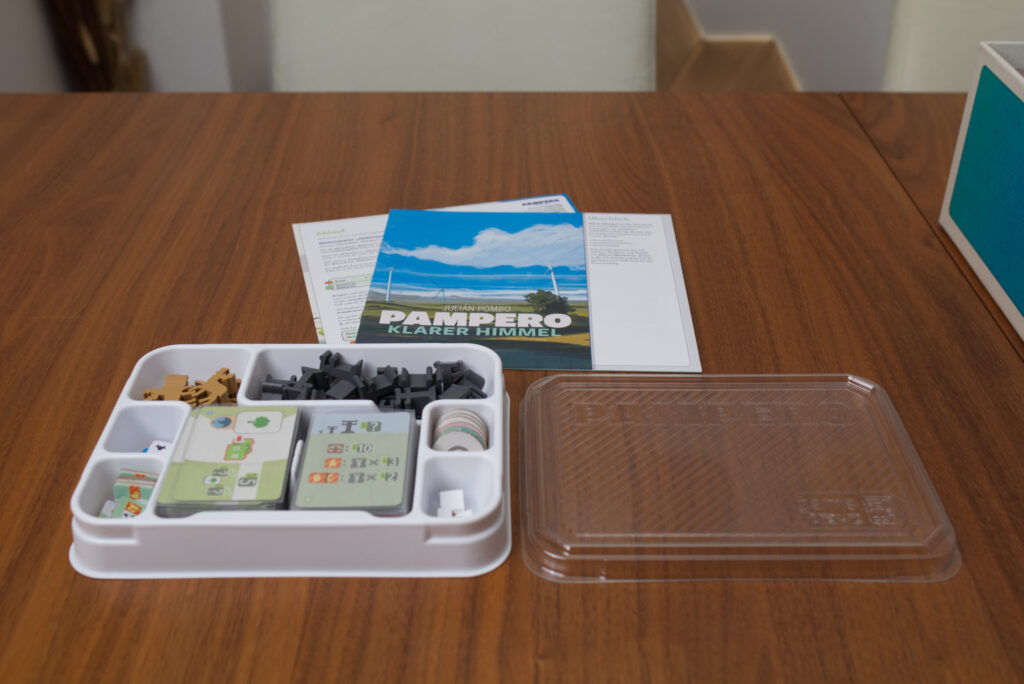
Game End & Normal vs Long Game
The game ends after the third scoring phase, so when all player markers have reached the last space of the time track. In the standard game this usually takes 5 rounds, 6 if there is at least one player that never skipped a turn to pick all cards back up. At that point, players repay their loans, play scoring cards they picked up during the game, and get points for tower bonus tiles that provide end game points. Speaking of which: money equals points in Pampero. So every time you paid an opponent to use their bulldozer or electrical tower, you actually gifted them sweet, sweet points! When you fulfilled a contract or built a tower, that actually did cost you money and thus points!
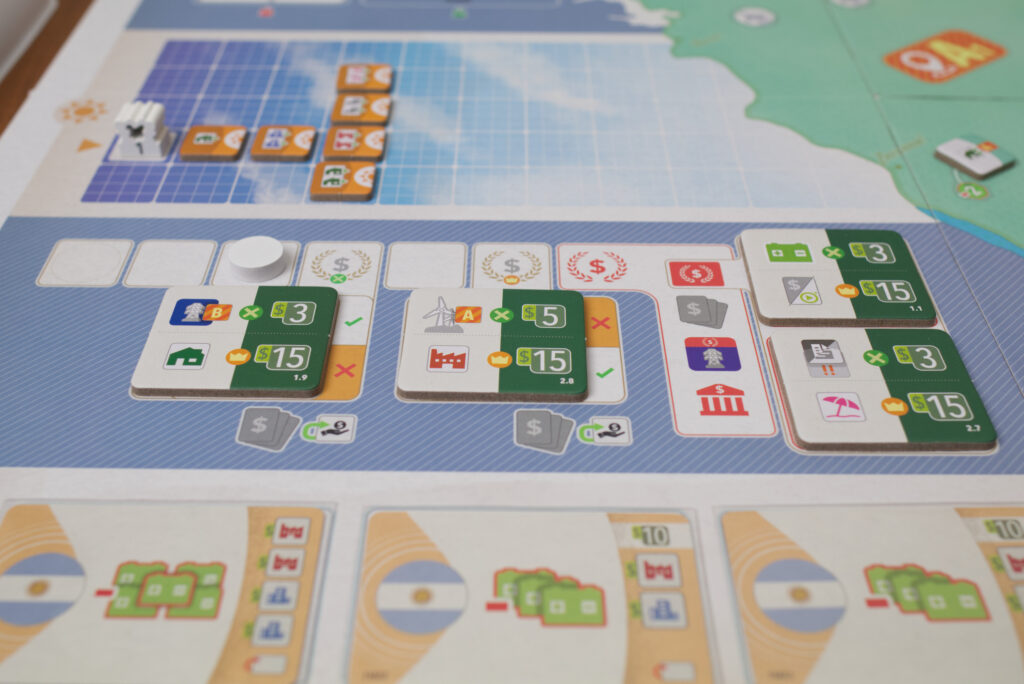
This unfortunately can lead to situations where it simply doesn’t make sense to do anything in the last round of the game because the return on invest is just too low. It particularly seems common during first plays when players don’t know yet how to really get their economy humming, so the cost of doing things in region C is too high for what they can get out of it. Fulfilling a 5 energy contract in C might look tempting because you get four bumps on income tracks. But is it worth all the money required to first get all that energy and then pay for using an electrical tower if one only gets incoming out of it one time? This initially felt to me like playing Wingspan where the only sensible thing to do in round four often was to produce eggs.
With more experience, it is possible to start working in region C within the first few rounds, and once that level is reached, the last round has more meaning. However, the standard game still leaves an aftertaste of being unsatisfying because one never has the time to really build up a sizable income and large parts of the grid board are never used. The foreign market cards hardly make sense because there is no real chance to get income markers high. This changes when playing the long version. It is only one round longer, but that round enables players to actually cache in on some of their investments. Suddenly building a 6th or 7th electrical tower can make sense, plotting a smart path through the grid has more chance of reaping high rewards, going for the foreign market becomes viable. I’ve switched back to the normal version just to double check how it feels and would strongly recommend to forget about it and always play the long version. Although, if someone in the normal game decides to never return all their cards, you effectively have the long game in the normal game, and … it’s complicated.
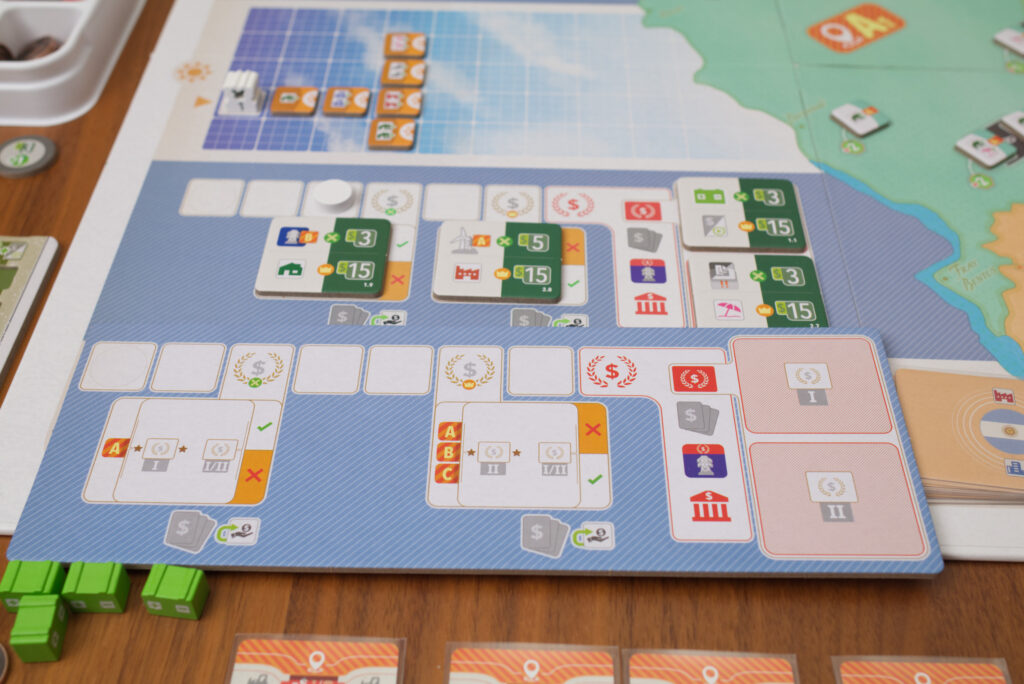
Solo Mode
I’ve played Pampero’s solo mode quite a bit by now. It comes with a deck of cards and an alternate grid board for the automa, but is not the draw a card to do an action kind of automa. Instead, during setup, the three cards that match the games second and third majority scoring goals are picked from the deck and placed to the left of the grid board. The rest of the cards are not needed and put back into the box.
On the automa’s turn, it checks in which of the scoring criteria it currently is behind the human player and selects the matching card to do something against it. The card contains various conditions and instructions on what to do: if it has no unlocked transformers, it will build an electrical tower. If it has not enough energy, it will build a wind farm. If it has enough of both, it will fulfil a contract. That structure is always the same but based on the majority it is fighting for, it builds in different regions or selects different contracts. The automa never has to pay for anything it builds and just keeps collecting money, raising the bar the human player has to reach.
Overall I would say it works, but with some serious shortcomings. The instruction cards are sometimes rather tricky to follow correctly and I on a number of occasions needed additional player aids available on BGG to properly interpret them. The automa also seems vulnerable to human players skipping the A regions rather quickly. At least I had some situations where I was already starting to work in region C and it still built wind farms in A that hardly produced any energy at all. And since it never uses the human player’s infrastructure, it is rather easy to lock it out of one of the B regions completely. I just played another session of solo Pampero and did the exact order of actions I did last time, and it worked equally well and without any serious interference by the automa in the first half of the game.
So a bit too tricky to learn and a bit too little incentive to repeatedly play against it in my opinion. But it works and was great to learn the pacing of the game. If the expansions would have been properly integrated, I could have seen myself playing against it a bit longer, but not much.
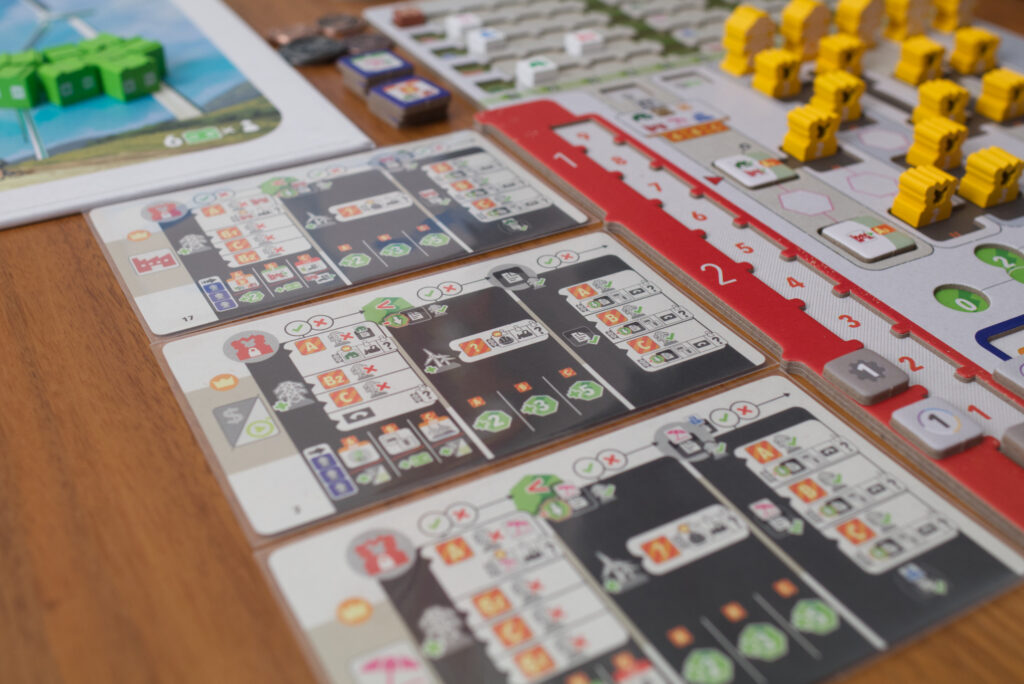
Metal Coins
Before we come to the conclusion, allow me a small detour. If you have read any of my previous pieces, you might have picked up on how much I enjoy having metal coins that are specifically made for a game. In case of Pampero, these are some of the best coins I’ve seen in a while. The illustrations are great, the thickness is good, the colour separation of the different denominations is good, they are just lovely. Do you need them to enjoy Pampero? No, it’s not like a John Company 2nd Edition or Pax Pamir where having the metal coins elevates the overall experience. But still: great design. My main concern would be if there are enough of them when playing 4p. Once I got somewhat competent in the game, I seemed to use up most of the 20s even when playing solo against the automa …
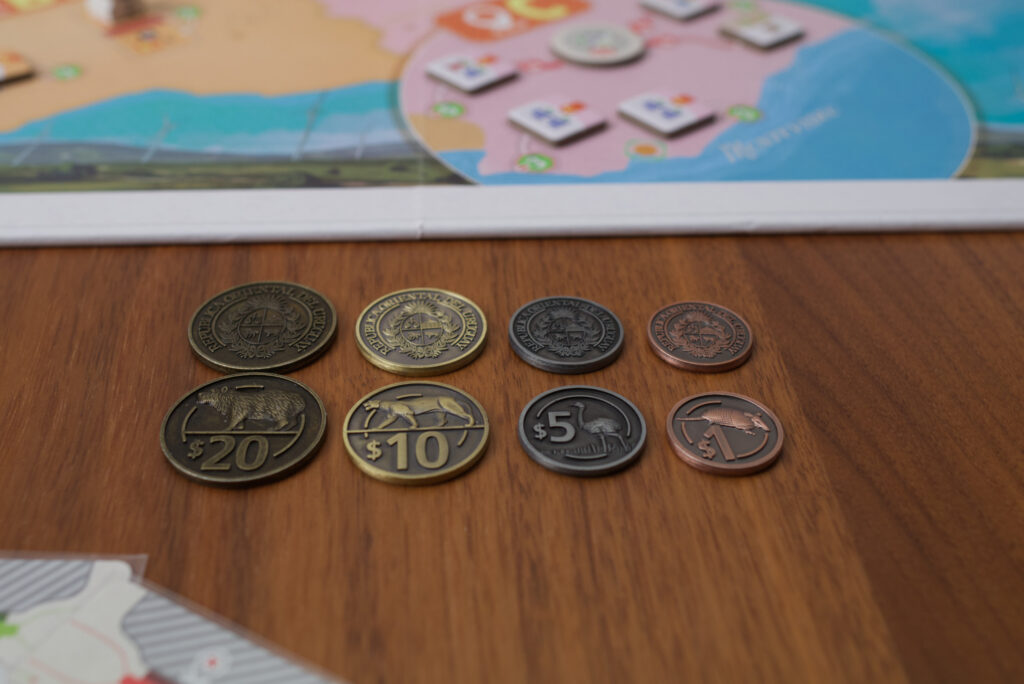
Conclusion
Pampero has been the first game in a while where I really struggled to write about it. Usually either some aspect of a game hooks me immediately and ideas for the writing process just keep flowing – or – I realise a game is (to me) not worth the hours I need to first play it an adequate number of times and then write about it, so I just sell it. Not every game is for everyone, that’s totally fine.
With Pampero though, I was mainly confused and wondering what was happening. I played it for the first time and thought “wait, that was it? That’s what I have been waiting for for so long?”. I had an unsatisfying first play and seriously considered if I should even give it a second try when self-doubt kicked in. Had I gotten some major rule wrong or was I just not good at it and needed to put more plays in for it to shine? It just felt so over-produced and under-developed, it didn’t match all the positive things I had heard before.
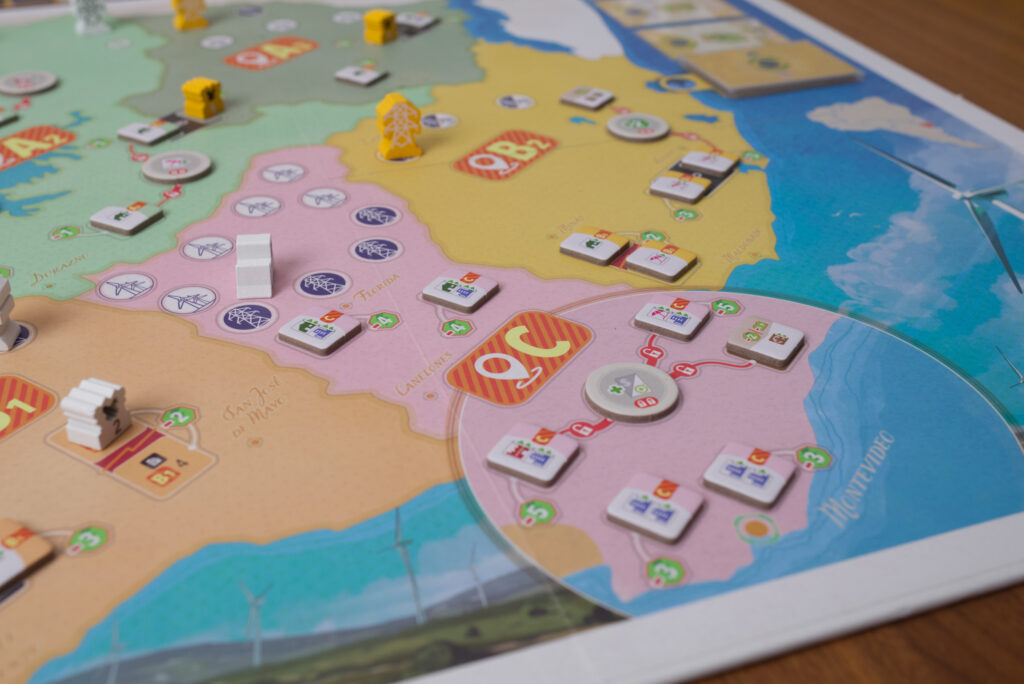
An immediate red flag and indicator that it might be the game and not me were the multiple small variants included in the base game. I’m sure they are well intended so that players can customise the game to their liking. However, they reminded me of a conversation I had with a well known board game designer years ago in which he said something along the lines of “if there are variants in a game, that usually means it wasn’t properly playtested and the designer hasn’t found the best version of the game yet.” This seems true to me here. For example, the variant to connect the limit how many batteries a player can hold to the number of electric towers they built sounds to me like a very interesting idea. But I don’t want to be the one that first has to play “normally” and then figure out the permutations of all the options and stretch goals that work best.
Then there are the oddities in the production. Why have player trays and then such an elaborate setup on the grid board? Why have two long strips of cardboard just for when someone picks up a certain discount tile from the electric tower bonuses? I had so many moments where I thought “this could have been solved so much simpler”. There’s a misprint/misalignment with one building space on the 3-4p side of the main board, my solo board was already delaminated in parts when I got it, the main board is very large but the areas for solar tiles and player order are mostly empty and immensely oversized, the screen printed numbers on the transformers just for 1-2 scoring tiles, … don’t get me wrong, the screen printed wooden bits look lovely, the trays are great quality, but it feels to me someone went 20-30% overboard compared to what the gameplay actually needed.
For me the biggest miss was to not make the longer version of the game the default. It really feels like everything was designed and balanced for the longer version and then someone decided that it would be too long to keep mass appeal and tried to quick fix it by chopping off a round. The size of the income tracks, the foreign markets, the amount of electrical towers and spaces to place contracts on the board, the number of contracts on the map and price of the C region, all of it made way more sense to me when playing the longer version.
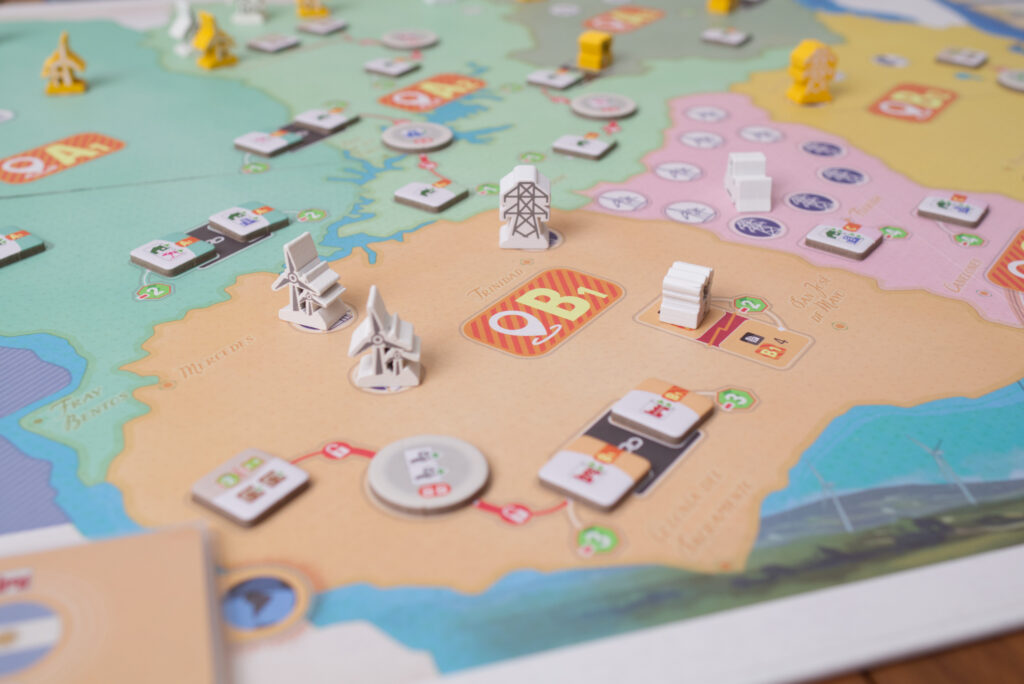
My second major issue with Pampero – and that clearly is a question of personal taste – is that it very much is an additive design, not one that feels polished and reduced to its essence. That’s why I believe the other popular comparison, that to Lacerda designs, is also unwarranted. Removing a single element from a Lacerda design usually makes the whole game ground to a halt like removing a cog from a watch. In Pampero I found myself instead wondering what I would have done as an editor. Did it really need the solar contracts if in most games only one or two are actually used because the only way to get them is via bonuses / bonus cards? The loan mechanism seems to be more a workaround for players that got themselves into a dead end rather than a viable tactical element like in Brass. The ability to use other peoples’ bulldozers and electrical towers seems to be in a design-limbo state between whether one should build them for others to use or rather use them to lock others out of lucrative areas.
As I said before, I only played Pampero solo and two player, it likely will have a different dynamic with 3+ (including the potential collusion issue mentioned before). But I still have a hard time wrapping my head around why I should have to pay the bank for my own electrical towers to fulfil a contract or my own bulldozer to build a wind farm / electrical tower. I could somehow justify that in my head, odd as it is, but why do I then not have to pay the same bank when I use another player’s pieces? It’s things like these where the mechanisms kept poking through that robbed me of any sense of playing a thematic game. Add on top of that one of the worst rulebooks I have had in years. It’s not that it’s badly written, but there are so many ambiguities in there that every game I played, we had multiple rules disputes that required going to BGG. Again signs of a game that would have benefited from more polish and reduction.
To sum it up, my feelings towards Pampero are mostly those of sadness. Not because it is a bad game or because someone didn’t pour a lot of effort and passion into it, but precisely because they did! There are lots of interesting elements in Pampero, the idea for the theme is great, the designer is super active and helpful in the BGG forums, a lot of work has been put into the production. It’s a shame it just doesn’t quite come together. It’s like a dough that has all the right ingredients, maybe a few too many nuts and embellishments, but you whisk it and whisk it and it just won’t become a cohesive thing. Cut and distill a few mechanisms, reduce the box in size by half, and this could have been an evergreen. The way it is now, it’s just one more example of why less is sometimes more and having big Kickstarter production budgets doesn’t necessarily make for better games.
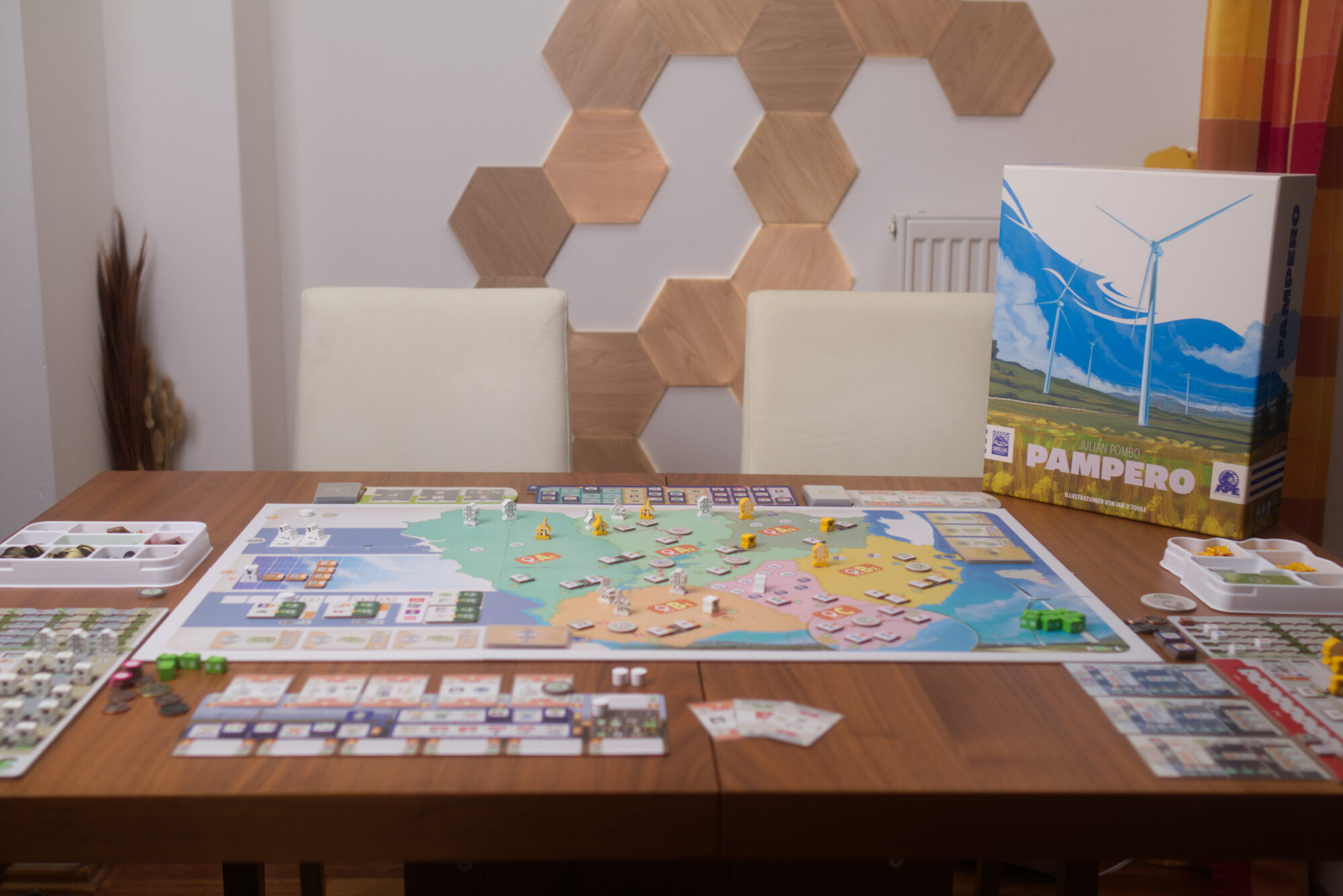
Great honest review! Much appreciated.
Thanks for the feedback. Unconscious Mind is a curios case. It looks like immense crowd funding hype is splitting now into two camps: those that feel it’s highly thematic and plays well on the one side and those for which the theme doesn’t come through at all and the gameplay is sub-par on the other. In recent years, I haven’t seen another game that is this decisive.
It took a while, but I’m relieved to see other critical reviews coming out now. Kind of felt like I was the only one in the beginning … together with the very positive reviews that exist, it creates a fuller picture of what one might or might not like about the game.